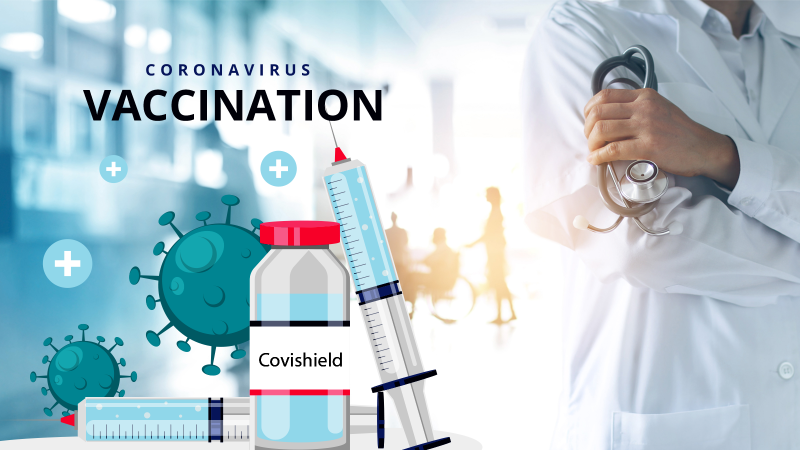
The Delta wave of Covid infection that hit India between April and June of 2021 was one of the worst waves that took away 2,40,000 lives. At the time of writing this article, India is reporting around 3,000 Covid-19 cases per day, according to the CSSEGISandData. We are also gingerly anticipating the fourth wave. Vaccination was posited to control infections and deaths caused in the previous waves.
As of now, around 63% of the Indian population is already vaccinated with two doses. The Covishield vaccine, developed by AstraZeneca and manufactured in India by the Serum Institute of India, was one of the two vaccines widely used, accounting for 90% of the doses given to adults. A team of scientists from CSIR Institute of Genomics and Integrative Biology, New Delhi, in collaboration with other institutes, now report that despite being vaccinated with Covishield, twenty-five per cent of health care workers sampled in a study conducted in Delhi during May-June 2021 were infected with the Delta strain. Though the vaccine remains effective in preventing severe infections, it might not have been successful in breaking the chain of transmission during the Delta wave. The study was published in the journal Nature Communications.
The effectiveness of a vaccine is determined by how many vaccinated persons get infected compared to the unvaccinated. Infections even after being vaccinated are called breakthrough infections. Commonly, breakthrough infections, like other regular infections, are detected by the RTPCR method, which looks for viral RNA in the sample. However, getting the accurate number of breakthrough infections using RT PCR tests is challenging because only persons with symptoms approach RT PCR testing. People who do not show any symptoms but have breakthrough infections can still transmit the virus to others. Moreover, vaccination reduces the symptoms and decreases the possibility of virus detection through RT PCR in collected swabs of breakthrough infections. To ensure that infections in the people studied are not missed, the present study looked for antibodies against the virus in the blood of infected people, which is a good indication of infection.
Researchers tested 597 health care workers from Delhi for breakthrough infections. The health care workers had received Covishield vaccines. The researchers compared the breakthrough infections with another group from the CSIR research institutes who had not received any vaccine yet. They checked for a specific type of antibody called anti-NC in both groups. Anti-NC is an antibody against the protein cover of the virus, different from anti-S is, an antibody developed against the spike protein of the Coronavirus.
Among the fully vaccinated (with double doses) who remained uninfected at day 45 after the vaccination, 25.3% had a breakthrough infection later. That means the vaccine protected about 74.7 % of persons from getting reinfected. When adjusted for age and gender, vaccine protectiveness fell to 70 %. Adjusting is necessary because immune response and antibody production differ according to age group and gender. When relaxed criteria of anti-NC (greater than two-fold increase in anti-NC and greater than five-fold increase in anti-S to qualify as a breakthrough) were used the effectiveness of the vaccine fell to 60 per cent. These estimates are similar to earlier reports from elsewhere, ranging from 67 to 79%. The vaccine protected only 45% of people from the group who had received just a single dose of the vaccine.
Interestingly, the researchers found that if a person was previously infected before receiving the vaccination, then the effectiveness of the vaccine in them was 99% because the previous infection would have produced antibodies against the virus. Together with antibodies, the antibodies from the vaccine create hybrid immunity, which is most effective against the virus. The immune system also remembers the previous viral infection. It is primed to respond to a new infection from the same virus effectively.
The researchers claim that though these observations were from a study group in India, they can also be applied to populations facing a Delta strain surge elsewhere. The researchers also observed that a person infected with a different strain earlier was not very well protected against the Delta strain. The number of anti-S antibodies produced by non-Delta strains, either through the previous infection or through vaccines created using non-Delta strains, was not sufficient to fight against the Delta strain. In lab tests, they observed that these antibodies were required at a higher amount of 1500 U/ml than the usual 1000 U/ml to neutralise the Delta strain.
The researchers also suggest that a booster dose of mRNA vaccines (where an mRNA segment is introduced into the body as a vaccine) might be essential. Though mRNA vaccines produce a high concentration of antibodies initially, when the antibody concentration starts declining, a booster dose that re-establishes high concentrations of antibodies is required to break the transmission of the virus. Mixing and matching different vaccine types like mRNA with Covishield also can provide better results.
Single doses of vaccination against the Delta variant are not effective and should be supplemented with a second dose as early as possible for the vulnerable population. But the results show that even a single dose for the people previously infected confers high protection. Therefore, double vaccinating the vulnerable population should be prioritised.
One important take-home message is that the hospitals need to continue to strictly adhere to using N95 masks, allow a limited number of patients to visit, maintain strict physical distance, and maintain good air circulation.
This research highlights that vaccination breakthroughs were more common in double vaccinated health care workers during the Delta virus outbreak and that natural infection through hybrid immunity provides a strongly boosted immune response against the Delta variant.





